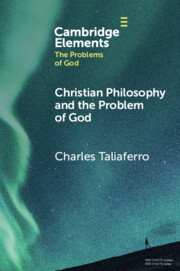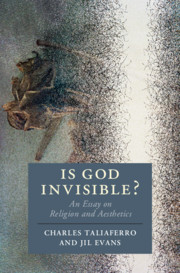79 results

Christian Philosophy and the Problem of God
-
- Published online:
- 12 June 2023
- Print publication:
- 06 July 2023
-
- Element
- Export citation
4 - Human and Nonhuman Animals from Secular and Sacred Perspectives
- from Part I - Concepts
-
-
- Book:
- The Cambridge Companion to Christianity and the Environment
- Published online:
- 21 July 2022
- Print publication:
- 04 August 2022, pp 48-62
-
- Chapter
- Export citation
8 - A Personal Guide to the Aesthetic Experience of Works of Art
-
- Book:
- Is God Invisible?
- Published online:
- 30 March 2021
- Print publication:
- 08 April 2021, pp 153-170
-
- Chapter
- Export citation
Web Figures
-
- Book:
- Is God Invisible?
- Published online:
- 30 March 2021
- Print publication:
- 08 April 2021, pp vii-vii
-
- Chapter
- Export citation
7 - Public Perception of Religious and Art Objects
-
- Book:
- Is God Invisible?
- Published online:
- 30 March 2021
- Print publication:
- 08 April 2021, pp 139-152
-
- Chapter
- Export citation
Contents
-
- Book:
- Is God Invisible?
- Published online:
- 30 March 2021
- Print publication:
- 08 April 2021, pp v-v
-
- Chapter
- Export citation
2 - Is God Invisible?
-
- Book:
- Is God Invisible?
- Published online:
- 30 March 2021
- Print publication:
- 08 April 2021, pp 16-39
-
- Chapter
- Export citation
Acknowledgments
-
- Book:
- Is God Invisible?
- Published online:
- 30 March 2021
- Print publication:
- 08 April 2021, pp viii-x
-
- Chapter
- Export citation
Introduction
-
- Book:
- Is God Invisible?
- Published online:
- 30 March 2021
- Print publication:
- 08 April 2021, pp 1-5
-
- Chapter
- Export citation
Copyright page
-
- Book:
- Is God Invisible?
- Published online:
- 30 March 2021
- Print publication:
- 08 April 2021, pp iv-iv
-
- Chapter
- Export citation
6 - Revealing and Concealing
-
- Book:
- Is God Invisible?
- Published online:
- 30 March 2021
- Print publication:
- 08 April 2021, pp 113-138
-
- Chapter
- Export citation
Figures
-
- Book:
- Is God Invisible?
- Published online:
- 30 March 2021
- Print publication:
- 08 April 2021, pp vi-vi
-
- Chapter
- Export citation
5 - The Beautiful Gate
-
- Book:
- Is God Invisible?
- Published online:
- 30 March 2021
- Print publication:
- 08 April 2021, pp 90-112
-
- Chapter
- Export citation
Epilogue
-
- Book:
- Is God Invisible?
- Published online:
- 30 March 2021
- Print publication:
- 08 April 2021, pp 171-171
-
- Chapter
- Export citation
Index
-
- Book:
- Is God Invisible?
- Published online:
- 30 March 2021
- Print publication:
- 08 April 2021, pp 172-180
-
- Chapter
- Export citation
4 - The Perception of Gates
-
- Book:
- Is God Invisible?
- Published online:
- 30 March 2021
- Print publication:
- 08 April 2021, pp 63-89
-
- Chapter
- Export citation
3 - The Gates of Perception
-
- Book:
- Is God Invisible?
- Published online:
- 30 March 2021
- Print publication:
- 08 April 2021, pp 40-62
-
- Chapter
- Export citation
1 - Aesthetic Personalism
-
- Book:
- Is God Invisible?
- Published online:
- 30 March 2021
- Print publication:
- 08 April 2021, pp 6-15
-
- Chapter
- Export citation

Is God Invisible?
- An Essay on Religion and Aesthetics
-
- Published online:
- 30 March 2021
- Print publication:
- 08 April 2021
3.4 - Value, Dualism, and Materialism
- from III - Engagements
-
-
- Book:
- Christian Platonism
- Published online:
- 20 January 2021
- Print publication:
- 17 December 2020, pp 432-449
-
- Chapter
- Export citation

